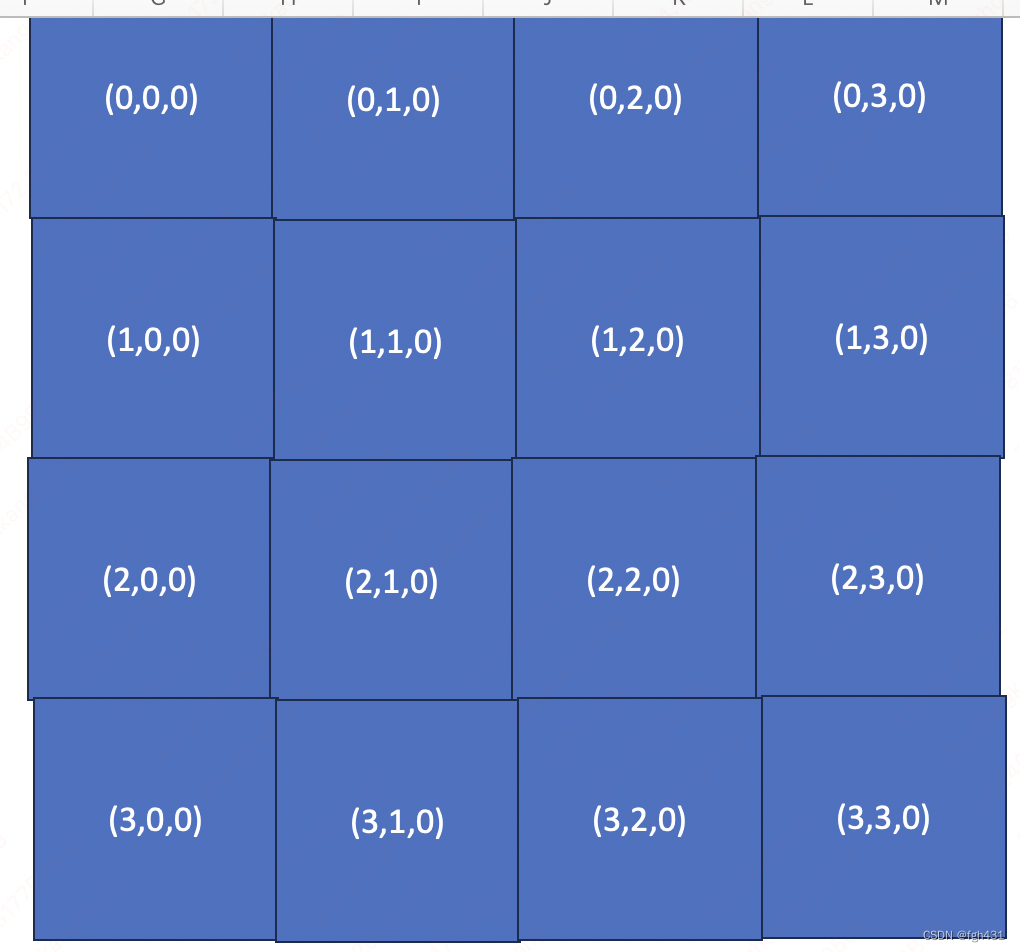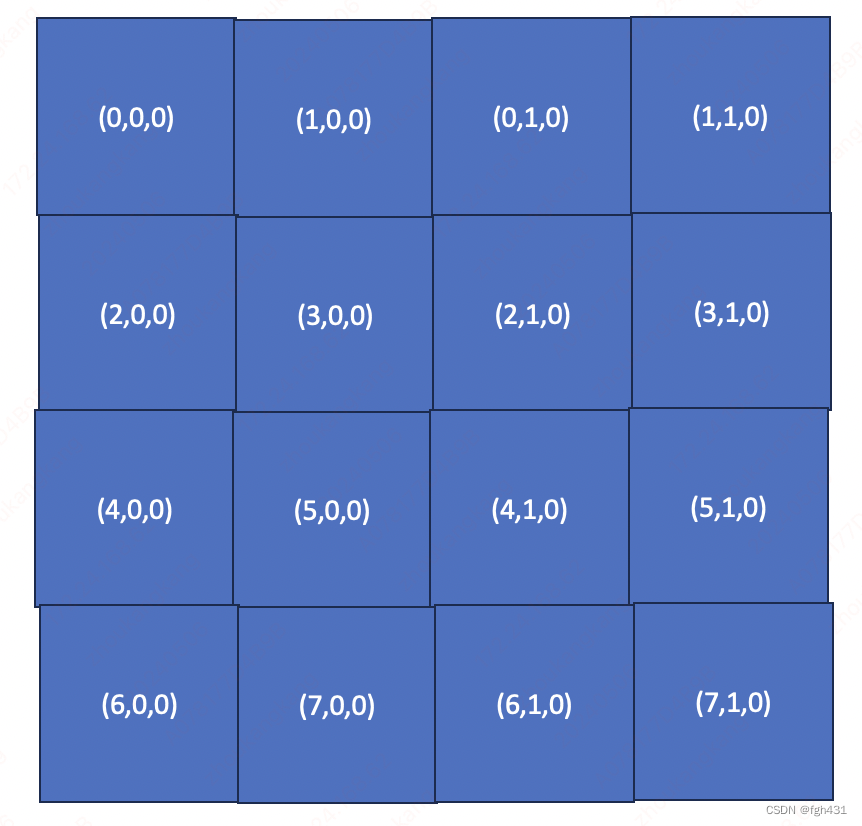文章目录
发表博客之:gemm/threadblock/threadblock_swizzle.h 文件夹讲解,cutlass深入讲解
- 在CSDN著名文章发表博客之:cutlass demo讲解,在sm75机器上用cuda core计算fp32矩阵乘!深入理解cutlass::gemm::device::Gemm类 ,感兴趣的老乡别走开!!里面我们介绍了
cutlass::gemm::device::Gemm的使用方式,以及这个模版类的一些参数,里面有一个模版参数叫ThreadblockSwizzle,并且当时他还有一个默认值typename threadblock::GemmIdentityThreadblockSwizzle<>,,不知道各位看官是否还记得,现在我要告诉你这个模版参数的准确作用!开心吗?
- 首先这个文件的github地址是cutlass/gemm/threadblock/threadblock_swizzle.h
- 我们知道,cuda 处理问题都是将一个很大规模的问题分成很多个小问题,每个小问题由一个ThreadBlock来处理,而
ThreadblockSwizzle就是负责将逻辑上的小问题映射到cuda上的ThreadBlock上。 - 或者直接引用这个文件上的注释吧!
Implements several possible threadblock-swizzling functions mapping blockIdx to GEMM problems.
先来看一下最简单的struct GemmIdentityThreadblockSwizzle结构体
- 这个结构体有一个默认参数是1。
template <int N = 1>
struct GemmIdentityThreadblockSwizzle {
CUTLASS_HOST_DEVICE
GemmIdentityThreadblockSwizzle() { }
/// Returns the shape of the problem in units of logical tiles
/// *Gemm* problem size: gemm(M, N, K)
/// 这个函数的作用是简单的。
/// 就是以tile_size为逻辑单元,整个问题的逻辑shape!
CUTLASS_HOST_DEVICE
static GemmCoord get_tiled_shape(
GemmCoord problem_size,
GemmCoord tile_size,
int split_k_slices) {
return GemmCoord(
(problem_size.m() + tile_size.m() - 1) / tile_size.m(),
(problem_size.n() + tile_size.n() - 1) / tile_size.n(),
split_k_slices);
}
/// Returns the shape of the problem in units of logical tiles
/// *ImplicitGemm* Conv2d problem size: conv_operator(NPQK, NHWC, KRSC)
CUTLASS_HOST_DEVICE
static GemmCoord get_tiled_shape(
cutlass::conv::Operator conv_operator,
cutlass::conv::Conv2dProblemSize const &problem_size,
GemmCoord tile_size,
int split_k_slices) {
gemm::GemmCoord implicit_gemm_problem_size =
cutlass::conv::implicit_gemm_problem_size(conv_operator, problem_size);
return get_tiled_shape(
implicit_gemm_problem_size, tile_size, split_k_slices);
}
/// Returns the shape of the problem in units of logical tiles
/// *ImplicitGemm* Conv3d problem size: conv_operator(NZPQK, NDHWC, KTRSC)
CUTLASS_HOST_DEVICE
static GemmCoord get_tiled_shape(
cutlass::conv::Operator conv_operator,
cutlass::conv::Conv3dProblemSize const &problem_size,
GemmCoord tile_size,
int split_k_slices) {
gemm::GemmCoord implicit_gemm_problem_size =
cutlass::conv::implicit_gemm_problem_size(conv_operator, problem_size);
return get_tiled_shape(
implicit_gemm_problem_size, tile_size, split_k_slices);
}
/// 这个函数是获得物理shape!也就是三对三对<<<>>>下的grid_shape!
/// Computes CUDA grid dimensions given a size in units of logical tiles
CUTLASS_HOST_DEVICE
static dim3 get_grid_shape(GemmCoord tiled_shape) {
int tile = 1 << get_log_tile(tiled_shape);
return dim3(tiled_shape.m() * tile, (tiled_shape.n() + tile - 1) / tile, tiled_shape.k());
}
- 下面的这个函数来获得最好的
get_log_tile!
/// 这个是防止函数是防止逻辑shape上的n过大,导致grid的第2维过大!
/// Calculates optimal swizzle width
CUTLASS_HOST_DEVICE
static int get_log_tile(GemmCoord tiled_shape) {
auto n = tiled_shape.n();
// Thresholds picked so that it doesn't cause too many no-op CTAs
if (N >= 8 && n >= 6)
return 3;
else if (N >= 4 && n >= 3)
return 2;
else if (N >= 2 && n >= 2)
return 1;
else
return 0;
}
- 下面两个函数是同一个名字,get_tile_offset,但是参数不同。
- 他们的共同作用根据物理id是获取
逻辑上Tile的偏移量!
- 他们的共同作用根据物理id是获取
- 但是第二个函数好像很少用到的样子!
/// Obtains the threadblock offset (in units of threadblock-scoped tiles)
CUTLASS_DEVICE
static GemmCoord get_tile_offset(int log_tile) {
int block_idx_x = RematerializeBlockIdxX();
int block_idx_y = RematerializeBlockIdxY();
int block_idx_z = RematerializeBlockIdxZ();
return GemmCoord{(block_idx_x >> log_tile), //
(block_idx_y << log_tile) + ((block_idx_x) & ((1 << (log_tile)) - 1)),
block_idx_z};
}
/// Obtains the threadblock offset (in units of threadblock-scoped tiles)
CUTLASS_DEVICE
static GemmCoord get_tile_offset(GemmCoord tiled_shape) {
int const kTile = N;
int block_idx_x = RematerializeBlockIdxX();
int block_idx_y = RematerializeBlockIdxY();
if ((tiled_shape.m() < kTile) || (tiled_shape.n() < kTile))
return GemmCoord{block_idx_x, block_idx_y, RematerializeBlockIdxZ()};
return GemmCoord{
(block_idx_x / kTile),
(block_idx_y * kTile) + (block_idx_x % kTile),
RematerializeBlockIdxZ()
};
}
};
- 举个例子,假设N=1,并且 C C C输出矩阵被分成下面这样的逻辑shape,
- 那么三对<<<>>>发射的grid就是(4,4,1)!
- 那么每个Tile被映射到的ThreadBlock id如下图所示。

如果 N = 2 N=2 N=2,
那么三对<<<>>>发射的grid就是(8,2,1)!
那么每个Tile被映射到的ThreadBlock id如下图所示。
